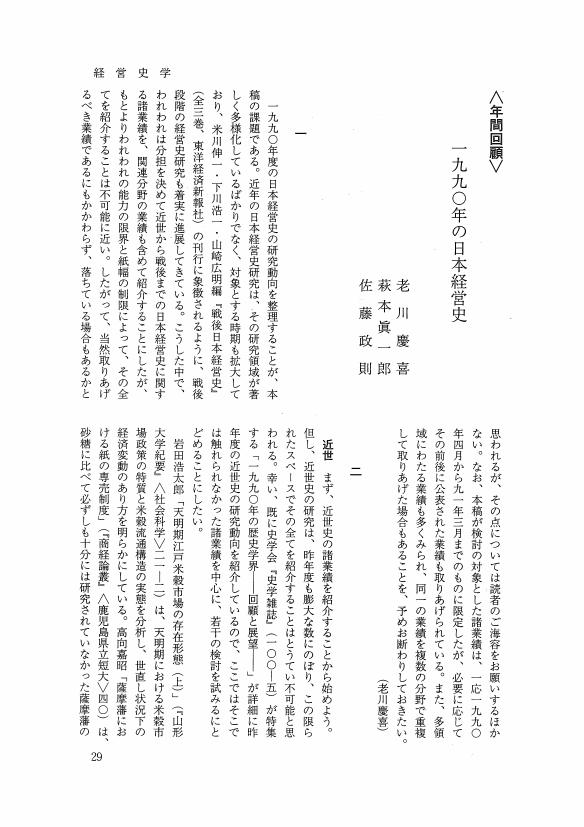3 0 0 0 OA 社風に応じた企業アーカイブを -歴史資料を現代と将来に活かす-
- 著者
- 佐藤 政則
- 出版者
- RIPESS麗澤大学経済社会総合研究センター
- 雑誌
- 経済社会総合研究センター Working Paper = RIPESS Working Paper
- 巻号頁・発行日
- no.60, 2014-03-24
2 0 0 0 OA 日銀引受国債発行とシンジケート銀行―大蔵省、日本銀行、シ団銀行の三位一体的考察―
1 0 0 0 OA 水準器を用いた長距離の真直度測定
- 著者
- 久米 達哉 奥山 栄樹 佐藤 政則 諏訪田 剛 古川 和朗
- 出版者
- 公益社団法人 精密工学会
- 雑誌
- 精密工学会学術講演会講演論文集 2010年度精密工学会春季大会
- 巻号頁・発行日
- pp.359-360, 2010 (Released:2010-09-01)
長距離における高精度な真直度測定の実現を目指して、水準器を用いる方法の適用可能性を検討した。実験では、69mの測定長において、測定間隔1~2mで傾斜角を逐次測定することで、傾斜角と真直度の繰返し性として、10μrad、42μm(σ)が得られた。これらを誤差伝搬モデルに当てはめると、測定間隔を1.9m、20cmとすることで、測定長500m、10kmで、1mm(2σ)未満の繰返し性が見積もられた。
1 0 0 0 明治三四年前後における高橋是清の日銀金融政策
- 著者
- 佐藤 政則
- 出版者
- 社会経済史学会
- 雑誌
- 社会経済史学 (ISSN:00380113)
- 巻号頁・発行日
- vol.50, no.5, pp.562-584,653-65, 1985
In the 1890s, the Bank of Japan played an important role in providing funds to the silk industry, the cotton mill industry, the foreign trade sector, etc., and accelerated the growth of these important industries. With the establishment of the gold standard, however, such a positive lending policy became difficult. The purpose of this paper is to elucidate how the lending policy changed in 1900-1901 under the Japanese gold standard. Particularly, it focuses on the policy directed by Korekiyo Takahashi, who was the Vice-Governor of the Bank at that time, and clarifies the difference between his policy and monetary policy carried out under the classical gold standard by Governor Tatsuo Yamamoto. The main points of Takahashi's were as follows: (1) He tried to balance trade deficit not by an increase in the official discount rate, but by an export promotion. Therefore, he tried to strengthen the export industries through aiding customers of the Bank to provide them with funds. (2) In order to do this, he adopted a managerial technique of deposit bank, and attempted to change long-term and rigid loans of the Bank into short-term and liquid ones. He succeeded in it to a considerable extent, so that he made the turnover of funds of the Bank quicker. (3) Moreover, not only did he systematize that policy in the Bank, but he demanded that customers of the Bank, that is, major commercial banks, should follow it. Thus, the change in lending policy had an important influence on managerial technique of her customers, and promoted the reorganization of financial institutions.
1 0 0 0 IR 国内外債市場と高橋是清:1897~1931
- 著者
- 佐藤 政則 永廣 顕 神山 恒雄 武田 勝 岸田 真 邊 英治
- 出版者
- 麗澤大学経済社会総合研究センター
- 雑誌
- 経済社会総合研究センター Working Paper = RIPESS Working Paper
- 巻号頁・発行日
- no.43, pp.i,ii-1~108, 2012-01-31
1 0 0 0 OA 一九九〇年の日本経営史
1 0 0 0 OA ジャイロを用いた高精度形状評価(第6報)
- 著者
- 久米 達哉 佐藤 政則 諏訪田 剛 古川 和朗 奥山 栄樹
- 出版者
- 公益社団法人 精密工学会
- 雑誌
- 精密工学会学術講演会講演論文集 2016年度精密工学会春季大会
- 巻号頁・発行日
- pp.49-50, 2016-03-01 (Released:2016-09-02)
我々は,形状基準を不要とすることから長尺対象物の高精度な形状評価に有効と考えられる,角度検出器を用いる形状評価法において,傾斜計では検出できない水平面内を含むあらゆる方位角が検出可能な,ジャイロを用いた方法について検討している.ここでは,角度検出方向と直交方向に回転するジャイロから得られる角度信号をもとに,地球自転軸を基準としてジャイロ回転軸の方位角を求める方法について,検討を行った.
- 著者
- 佐藤 政則
- 出版者
- 法政大学経済学部学会
- 雑誌
- 経済志林 (ISSN:00229741)
- 巻号頁・発行日
- vol.82, no.4, pp.191-204, 2015-03
It was the financial institutions that purchased the majority of the Bank of Japan's underwriting of government bonds during the term in which Korekiyo Takahashi served as Finance Minister. The central agent was the underwriting syndicated banks. Furthermore, it was the so-called Big Five, i.e. Mitsui Bank, Mitsubishi Bank, Sumitomo Bank, First Bank, and Sanwa Bank, which constituted the core of the syndicated bank group. However, the former two banks were the dominant agents in this group. Indeed, it was the investment surplus in the government bonds by these two core banks that sustained the stable absorbtion of the government bonds in Takahashi's term. However, since the selling operations of the Bank of Japan, which made possible such stable digestion of the government bonds in this period, were dominated and controlled by these two major banks, their relinquishment of the dominant control would reveal and precipitate a fragile and shallow market, i.e. the limitations of, the so-called, "stability of funding the government bonds."
